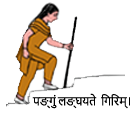Low back pain, i.e., pain below lower rib margins, is a problem of middle-aged people with a lifetime prevalence of over 80%. It is an important cause of work absenteeism. Recurrent back pain occurs in almost 20% of individuals. Sciatica is a condition in which this pain radiates to one of the lower limbs. Sciatica occurs due to displacement of disc leading to compression of nerve fibers emerging from the spine. Pain in legs worsened by walking or prolonged standing (neurogenic claudication) and relieved by rest is an ominous feature of spinal canal narrowing (stenosis). Many patients have inappropriate information and beliefs about low back pain and respond inappropriately to pain (fear of pain, avoidance of movements, etc.). Depression, anxiety, and low job satisfaction are common in these patients.
Danger signals (See your doctor at the earliest)
| Age: less than 20 or more than 50 | Leg, bladder or bowel complaints |
| Deformity of spine | Fever |
| Recent injury | Loss of weight |
| Prolonged stiffness in mornings | Unwell feeling |
| Pain awakening at night | Prolonged use of glucocorticoids |
| No relief with rest | Drug abuse |
| Significant relief with pain killers | HIV Infection |
Nonspecific low back pain (no identifiable cause) does not require any investigations. X-rays, CT scan, MRI, or Isotope Bone Scan should be done in selected cases for specific indications only.
Causes: A wrong posture is the most common cause of most back pain. Lumbar spondylosis, an aging phenomenon, is a usual X-ray finding after the age of 40 years. It does not necessarily indicate the cause of back pain.
Back pain is likely to develop and become chronic in the following situations:
- A previous episode of low back pain
- Heavy physical work, e.g., pulling, pushing, lifting, etc.
- Jobs involving vibrations (heavy vehicles) or sedentary work
- Lack of social support, low job satisfaction, night shifts
- Distress and depression
- Unemployment, low levels of education
- Obesity
Less than 15% of patients with low back pain have a specific cause for back pain. Some of these causes include fractures, disc protrusion, osteoporosis, ankylosing spondylitis, infections (such as tuberculosis), and tumor.
Treatment: Though chances of recurrence are high, acute low back pain usually resolves within six weeks. Back discipline is essential for the prevention of recurrence. Drugs that relieve pain and spasm should be used for the shortest possible period. ‘Stay active’ is the rule for faster recovery. Bed rest must be discouraged as it leads to stiffness of joints, weakens muscles and bones, and can cause clotting in leg vessels. Prolonged traction may have similar adverse effects. Prolonged use of a back brace is not advisable as it can also cause muscle weakness. Avoid fear and anxiety, assure yourself that there is no serious illness, get more information about nonspecific back pain and do exercises under guidance from a physiotherapist. Walking, cycling, and swimming are good preliminary exercises. Back schools are helpful for short-term pain relief. A psychologist can be of great help in changing cognition and behavior. Family members, too, must be involved in behavioral therapy for patients with chronic low back pain. Yoga postures are proven to be beneficial in management. Acupuncture, massage, dry and moist heat, ultrasound, spinal manipulation, and Transcutaneous Electric Nerve Stimulation (TENS) are other complementary methods for pain relief.
The efficacy of local injections of glucocorticoids or other drugs is yet to be proven. They may be required to be repeated even if effective in some cases. Immediate surgery is indicated in any neurological involvement. Chances of natural resorption are higher in larger disc herniations. Disc surgery eliminates mechanical problems though results can be variable in individual patients. It relieves leg pain but not back pain in patients with sciatica. No difference is observed in the status of operated versus non-operated cases at the end of 2 years.
Prevention of Back Pain:
- Stand straight, stand on broad base with feet apart.
- Maintain normal spinal curvatures. Keep your head straight, chin parallel to the floor, shoulders in line with ears, and abdomen as flat as possible.
- Bend at knees while leaning forwards (washbasin). Use a footrest during prolonged standing (kitchen, ironing, etc.).
- Avoid high heels. Wear proper and comfortable shoes.
- Do not bend forwards to lift weight – flex at knees, hold the object and stand up. Hold object closer to you. Push heavy objects with your back (car) rather than pushing or pulling them with your hands. Never lift heavy weight on your side without turning around.
- Choose a proper chair. Your lower back must touch the backrest. Use a small pillow or commercial backrests if required.
- Sit straight with feet resting on the ground, knees and thighs flexed to 90 degrees. The back can be straightened by tightening abdominal muscles. Use a footrest if required.
- Reclining chair forwards, using a footrest, or placing one thigh over another make your back straight.
- Use a seatbelt while driving. Sit close to pedals and keep back straight.
- Lying on a side with knees bent is good for your back. Support knees with an appropriate pillow if you lie on your back. Never sleep on your belly.
- Turn on one side to get up from bed.
- Avoid a very soft or a hard mattress. Avoid sleeping on uneven surfaces.
- Reduce weight with proper diet and exercise.
- Exercise regularly.
